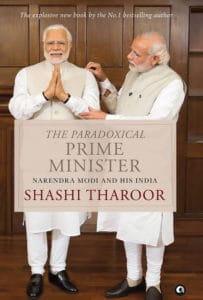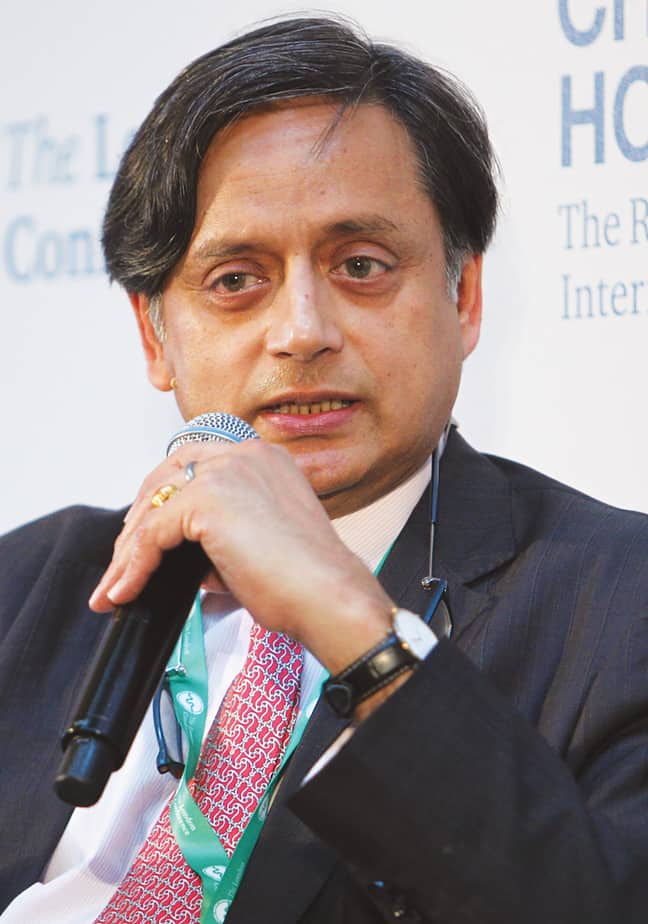Shashi Tharoor’s book takes too many polemical detours to serve as an authentic account of Narendra Modi’s tenure as Prime Minister
In His introduction to The Paradoxical Prime Minister (Aleph), Shashi Tharoor berates the binaries of black-and-white in our political discourse and pitches the book as an effort made by “a fair-minded Opposition MP looking back at the Modi years”. In the five sections of the book, further divided into 50 chapters, he fails in elevating his critique of Modi’s tenure in the South Block to a seminality of historical insights.
Tharoor is stating the obvious in saying that the Prime Minister echoes the liberal views on public platforms, while the ideological mandate of his electoral appeal and triumphs is largely conservative. But what shouldn’t surprise Tharoor is that the conciliation of contradictions and mediation of seemingly irreconcilable claims are one of the functions of modern democracies. Leaders embodying such contradictions and mediation of interests are products of the same process.
What Tharoor fails in identifying is that far from being an unnatural aberration, different forms of identity politics are intrinsic to India’s political life. Modi’s victory, or, for that matter, his possible defeat (or what Tharoor calls his “undoing”), isn’t relevant for the stream of cultural conservatism which has always been there and will stay—sometimes asserting itself more, sometimes less. It’s the political conservatism which came of age in 2014 under Modi and will have its own cycle of wins and defeats. In the process, it may embrace as well as distance cultural projects, blending conviction with convenience.
The section titled “The Modi-fication of India’’ containing 15 chapters raises valid concerns regarding dubious plans and sporadic attempts at historical distortion, rewriting and planting of questionable facts by elements within the Indian Right who treat history as a political project. What, however, negates his concern is his unquestioning acceptance of ideologically convenient accounts of India’s past offered by predominantly Left-leaning historians in school and university texts.
It’s amusing that Tharoor prioritises ideological projects over unalloyed curiosity for exploring the past. For instance, in failing to register or using euphemisms for numerous acts of cultural vandalism perpetrated in medieval India, Tharoor ends up siding with not only convenient versions of history but sometimes even with grossly dishonest academic exercises. It was evident in the unnecessary space Tharoor gives to discuss deeply flawed reasoning of someone like Audrey Truschke. One expected Tharoor to be aware of her recent acts of subverting even basic norms of academic argument, including misquoting a source she had cited in her defence.
Tharoor’s previous book Why I Am a Hindu (Aleph, 2018) talked about Sanskrit texts without going through the rigours of grasping the Sanskrit language. The Paradoxical Prime Minister lacks a stamp of personal investment in research. In all the sections, he wades through assorted material to make a point or two. Most points seem current affairs revisited, though they provide a recap of issues on which the Modi regime can be held accountable.
While chapters on communal violence, mob lynching and cow vigilantism are expectedly there, they don’t go beyond media narratives to develop a nuanced understanding of the subject. For instance, the chapter on cow vigilantism politics could have tried to also look at the other side of the working and challenges of genuine and law-abiding cow protection groups, and how they are striving to shield a way of life and cattle-based rural economies.
This could have also led Tharoor to discover the fact that the history of cow protection in modern India goes far back, and includes figures he has shown admiration for in the book—Mahatma Gandhi and Dayanand Saraswati. Gandhi, as Tharoor rightly points out, opposed the imposition of a ban on cow slaughter despite his belief in cow protection. What, however, should also be remembered is that Gandhi, unlike Hindu Mahasabha’s VD Savarkar, in his writings in Young India had regarded cow protection as an essential part of Hinduism and the duty of all Hindus. Dayanand Saraswati, whom Tharoor credits with teaching “inclusive and self-interrogating Hinduism”, founded the first Gaurakshini Sabha of modern India in 1882.

Removed from their social contexts, some chapters end up as poor guides to understanding certain policy responses. In such cases, Tharoor abandons holistic analysis for the confined templates of English media narratives. For instance, while talking about anti-Romeo squads in Uttar Pradesh, he heavily relies on how the English media approached the issue and in the process shows a complete disconnect with how a large section of people in the state viewed the issue. A look at people’s responses and how the local media reported on it would have provided a more useful insight. It might have made him aware that the poll promise of dedicated squads and the strict crackdown on stalking and eve-teasing received popular support in many parts of the state.
In examining the Modi government’s approach to Sangh-mandated cultural projects, Tharoor could have reflected on the tussle between political costs and limited state capacity on one side and the Sangh’s anxieties about the marginalisation of cultural agenda on the other. This would have been interesting, given the fact that Tharoor repeatedly talks about the autonomy that Modi has carved out for himself in the conduct of the party and the government.
Tharoor’s section on Modi’s poor performance in governance has short chapters on themes ranging from institutions to Parliament, and from matters of justice and cutting red-tape to the dismal state of its flagship Swachh Bharat. A longer chapter on civil services reforms, or the lack of it, would have been welcome. One says so because that’s one of the starkest failures of the current regime and one which witnessed various false starts to recoil back to the status quo.
However, when talking about Modi’s drive for creating a bureaucratic ecosystem, Tharoor discounts the anxieties in the political class in dealing with what they consider entrenched power interests. That may sometimes be real and sometimes imagined too. The second aspect could be of ideological and loyalty alignments. In this context, Tharoor could have talked about the ideological construct of “committed bureaucracy” developed in the 1970s under the Indira Gandhi regime. It impinged on the principles of neutrality in civil services while seeking ideological alignment with the government’s policy framework.
On matters of economy, Tharoor chooses issues like the dismal rate of job creation and dramatic measures like demonetisation to expose the Modi government’s key failures. He relies on data and analysis offered by different experts as well as official documents. There isn’t anything new here which one may not come across in the usual news and analysis cycle. To an extent, the chapters in this section suffer from a dilettante’s handling and end up stating the obvious.
The Modi government’s failures in the conduct of international relations, particularly after the glow of initial promise in its engagement with big powers and its neighbours, is covered in the last section. Modi’s initial investment of personal energy in foreign affairs impresses Tharoor who then analyses its subsequent setbacks and loss of direction. He argues that attempts to chart its own course, say elements of change, in foreign policy have largely led to setbacks, while elements of continuity with India’s traditional foreign policy positions have brought rewards for the current foreign policy establishment too.
One theoretical question which Tharoor, with a career in UN diplomacy, could have examined for readers is: Has Modi’s foreign policy regime faltered in balancing the quest for strategic autonomy and the demands of complex interdependence? As Tharoor has often dwelt on it, one expected him to reflect on the little effort being made by the government in expanding the severely understaffed foreign service, a mismatch given country’s size and aspirations of emerging as a global power.
What all these sections lack is a thematic cohesiveness. There are times when the lack of an editorial anchor make different chapters read like islands adrift. Some chapters fail to rise above rambling jottings or a series of sound bites to television channels.
The Paradoxical Prime Minister is a casualty of the lack of historical distance, demands of ideological counter and know-all dilettantism. To its credit, it still manages to ask some relevant questions and make some of the right noises.
www.newslaundry.com





